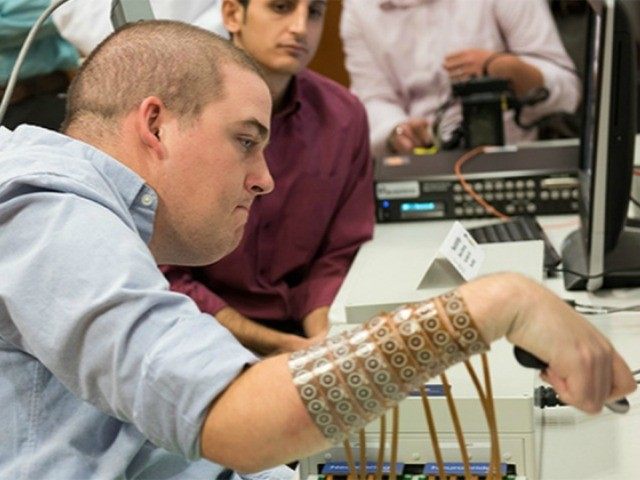The first quadriplegic to experience limb reanimation is Ian Burkhart, courtesy of a cutting-edge chip that bypasses his spinal cord altogether.
When Burkhart broke his neck while diving, he lost all feeling in both his arms and legs. In any other time in history, that would simply have been a tragic end to the story of a promising young man with all of his life ahead of him.
But just this past Wednesday, doctors reported that a chip implanted in his brain gave back control of his right arm and hand. The chip was connected to a sleeve on his arm, and, with practice, Ian was able to pick up and pour from a bottle, stir with a straw, and even play a bit of Guitar Hero.
Without actual sensation in the hand, Burkhart had to concentrate and pay attention to when he was contracting and releasing his fingers in order to use them. And for now, the limb reanimation is only functional when attached to a machine. Still, it’s an important leap forward in the quest to cure paralysis. In the future, the evolution of this technology could be used to return near-complete limb usage to those otherwise bound to a wheelchair for life.
Rajesh Rao, Director of the Center for Sensorimotor Neural Engineering at the University of Washington, is very optimistic about the future use of this technology:
It’s quite impressive what they’ve shown, this sequence of movements to pick up and pour something and pick up a stirrer — it’s an advance toward a goal we all have, to provide as much independence to these patients as possible.
Burkart’s willingness to participate in the experiments were challenged by his family, who were uncertain that the medical risks involved were worth the potential rewards. Aside from the obvious dangers involved in the installation and extraction of the chip, there was no guarantee that the progress made would directly benefit Ian at all. Ian’s father Doug Burkhart says that “he was doing it for the general good, to move the science along.”
But Ian would not be dissuaded from what he sees as an essential need for progression in helping “people like [him].” In his words, “why not try?” And that’s exactly what they did, on the back of a determination that Doug likens to Ian’s grandfather:
He’s one of those people, he’s driven, he’s decisive, once he makes a decision, he sees it through and doesn’t look back. He was going to do what he wanted to do.
Like previous advances that have allowed people to control everything from computers to flying drones with their minds, the chip in Burkhart’s brain took specific nerve signals for limb movement and translated them directly from his brain to a sleeve that offered control of his right hand.
The doctors worked for an hour and a half just to find the right place to insert the 96 “microelectrode” chip, but that was barely the beginning. Progress in the usage of the limb took weeks. Burkhart spent hours with a cable connected to his skull, reading the firings of neurons in his brain through the chip.
As he learned, those signals changed, requiring near-constant recalibration. According to Battelle research leader Dr. Herbert Bresler, “The signal changes constantly as learning happens, and we had to adjust to those changes. The machine learned as Ian Burkhart learned.”
It was a grueling year of training before Ian could perform the simple act of pouring himself a drink and stirring it. For a long time he was straining to imitate the movements portrayed by an on-screen avatar, but the young man approached it like a sport. “You work, and gradually it gets easier,” he said.
Ohio State, Battelle, and private donors have kept the project alive thus far, but the money is almost gone. Without additional support, Burkhart will return to the life to which he has been sentenced by circumstance.
If I could take the thing home, it would give me so much more independence. Now, I’ve got to rely on someone else for so many things, like getting dressed, brushing my teeth — all that. I just want other people to hear about this and know that there’s hope. Something will come around that makes living with this injury better.
Regardless of Ian Burkhart’s immediate future, his determined efforts and hard work have paved the way for advancements that could change the lives of countless other people. He may have only poured himself a drink, but he poured it like a hero.
Follow Nate Church @Get2Church on Twitter for the latest news in gaming and technology, and snarky opinions on both.

COMMENTS
Please let us know if you're having issues with commenting.